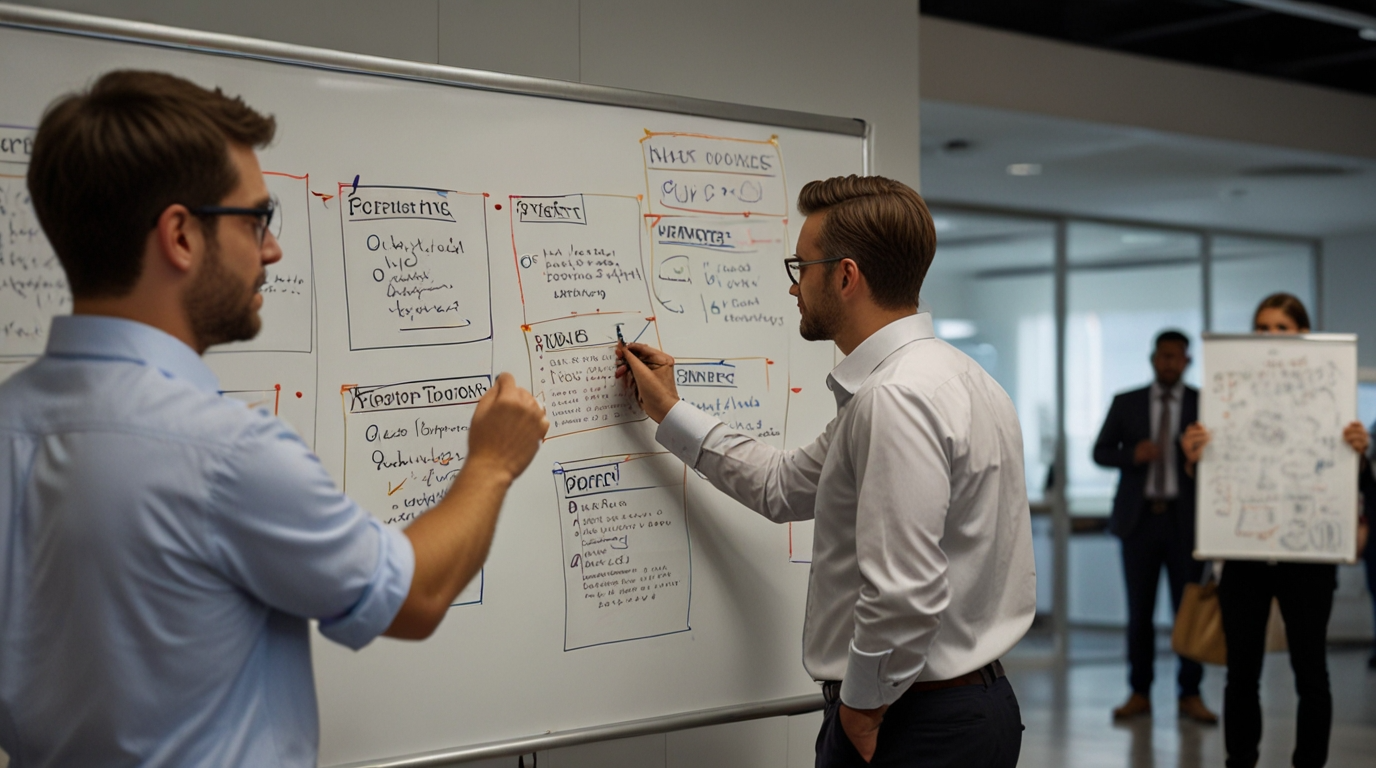Have you ever been torn between seeing the big picture and getting lost in the details? As a project manager, I’ve often struggled with this dilemma. On one hand, I need to keep my eye on the long-term goals and vision for the project, ensuring that all the pieces fit together seamlessly. On the other hand, I can’t ignore the small details that can make or break the endeavor’s success.
It’s a constant balancing act that can be challenging to navigate. But over the years, I’ve realized that being big-picture and detail-oriented is possible and essential for success in both personal and professional life.
Imagine you’re planning a surprise birthday party for your best friend. You have a grand vision of the perfect celebration, with decorations, music, and a gourmet menu. But as you start to plan, you realize that there are countless details to consider – from the guest list and invitations to the event’s timing and the attendees’ dietary restrictions.
If you focus solely on the big picture, you might end up with a beautiful concept that falls apart in execution. The invitations might not go out on time, the venue might be double-booked, or the cake might not arrive. On the flip side, if you get too caught up in the details, you might lose sight of the overall goal – to create a memorable and joyful experience for your friend.
The key is to find a balance between the two—to be a big-picture thinker who can also appreciate and manage the fine details. This skill takes practice and patience, but it can pay off in spades.
This post will explore the art of balancing big-picture thinking and detail orientation. We’ll look at real-world examples of people who have mastered this skill and provide practical strategies for developing both traits in your own life. Whether you’re a project manager, a team member, or someone who wants to achieve their goals more effectively, this post is for you.
So, let’s dive in and discover how to master both the big picture and the details.
Understanding Big Picture Thinking to Identify Patterns

Big-picture thinking is a cognitive approach focusing on the broader context and long-term implications of decisions, projects, and goals. It involves looking beyond the immediate details and considering how various elements fit together to form a cohesive whole.
Big picture-oriented individuals focus on broader ideas and goals, often associated with personality types that prioritize overall priorities over perfectionism. They are contrasted with detail-oriented individuals who analyze specific data and information.
Characteristics of big-picture thinkers include:
Ability to identify patterns and connections between seemingly disparate ideas
Comfort with ambiguity and abstract concepts
Tendency to prioritize overall priorities over perfectionism
Willingness to delegate detail-oriented tasks to maintain a broader perspective
Benefits of big-picture thinking in the workplace include:
Fostering innovation by considering new approaches and ideas
Creating and pursuing long-term goals that align with organizational objectives
Identifying business solutions that meet the needs of people across departments
Maintaining a growth mindset and learning from experiences
Examples of successful big-picture thinkers can be found across various fields. Climate activist Greta Thunberg demonstrates big-picture thinking by looking beyond everyday energy use to consider the long-term impact on the planet and future generations. In the business world, big-picture thinkers are often suited to focusing on larger, enterprise-oriented projects where their ability to identify patterns can help find comprehensive solutions.
However, it’s important to note that while big-picture thinking is valuable, it is most effective when balanced with detail-oriented thinking. Companies need both the dreamers and the doers, the risk-takers and the risk-averse, to succeed. By understanding and leveraging both cognitive approaches, teams can optimize their problem-solving capabilities and foster continuous innovation.
The Value of Being Detail Oriented

Detail orientation is the ability to pay close attention to the specifics of a task or project, ensuring accuracy and completeness. Detail-oriented people are meticulous and thorough and take pride in their work.
Detail oriented thinkers are crucial in fields requiring precision and accuracy, such as medicine, engineering, or accounting. They ensure that all the small details are taken care of, complementing big picture thinking.
Characteristics of detail-oriented individuals include:
Strong observation skills and the ability to notice minor details
Focus on causes rather than effects, seeking to understand the reason behind a task
High standards and a desire to prevent potential issues
Patience and perseverance in completing tasks accurately
The benefits of being detail-oriented in the workplace are numerous:
Consistently performing tasks impeccably, leading to high-quality work
Identifying potential roadblocks and taking steps to prevent them
Meeting deadlines and managing time effectively
Being chosen to lead important projects due to reliability and attention to detail
Examples of successful, detail-oriented individuals can be found in various roles and industries. Administrative assistants, paralegals, and data assistants are often detail-oriented, as their roles require meticulous completion of assignments. In creative fields, detail-oriented people may excel at proofreading, editing, and quality control tasks.
However, it’s important to note that being too detail-oriented can have drawbacks. Perfectionism can lead to difficulty starting or completing tasks, and an excessive focus on minutiae can hinder big-picture thinking. The key is to balance attention to detail and efficiency, leveraging the strengths of detail orientation while also considering a project’s broader context and goals.
Job seekers can demonstrate their value to potential employers by showcasing their detail-oriented skills. Highlighting experiences that required organizing presentations, managing data, or crafting personalized communications can illustrate a candidate’s attention to detail and commitment to quality work.
Strategies for Balancing Big Picture Thinking and Detail Orientation

While big-picture thinking and detail orientation may seem like opposing skills, it is possible to cultivate both and leverage them for greater success. Here are some strategies to help balance these two cognitive approaches:
A. Develop self-awareness: Understanding your natural tendencies and strengths is the first step in finding balance. Reflect on whether you tend to focus more on the big picture or the details, and consider how this impacts your work and decision-making.
B. Prioritize and delegate: Big-picture thinkers can benefit from prioritizing tasks and delegating detail-oriented work to others when possible. This allows them to maintain a broader perspective while ensuring that important specifics are not overlooked.
C. Use tools and techniques to manage details: Detail-oriented individuals can use checklists, project management software, and calendars to keep track of small details without getting overwhelmed. This frees up mental space to consider the larger context and long-term goals. Focusing on little details can be challenging, but these tools help manage them effectively.
D. Foster collaboration with complementary skill sets: Teamwork is key to balancing big-picture thinking and detail orientation. By collaborating with others who have complementary strengths, individuals can learn from each other and create more comprehensive solutions. Brainstorming sessions and open communication can help teams generate new ideas while also considering practical implications.
E. Continuously learn and adapt: Balancing big-picture thinking and detail orientation is ongoing. Seek opportunities to develop skills in both areas through formal training, mentorship, or on-the-job learning. Regularly assess what is working well and what could be improved, and adapt strategies as needed.
By developing self-awareness, using tools effectively, fostering collaboration, and continuously learning, individuals and teams can successfully balance big-picture thinking and detail orientation. This leads to more innovative ideas, practical solutions, and, ultimately, greater success in achieving long-term goals.
Real-World Examples of Balancing Big Picture Thinking and Detail Orientation
To better understand how balancing big-picture thinking and detail orientation can lead to success, let’s explore some real-world case studies:
A. Case Study 1: Design Thinking at Airbnb
Airbnb, the popular online marketplace for lodging and tourism, faced challenges in its early days. By applying design thinking principles, which involve a balance of big-picture vision and attention to detail, the company was able to climb out of the “trough of sorrow” and achieve massive success. The design thinking process involves empathizing with users, defining problems, ideating solutions, prototyping, testing, and implementing—a combination of big-picture strategies and detail-oriented execution.
B. Case Study 2: PillPack’s Success through Human-Centered Design
PillPack, a startup simplifying medication management, began as a startup-in-residence at IDEO Cambridge. By working with designers and using a human-centered approach that balanced big-picture branding with detail-oriented user experience, PillPack refined its vision, strategy, and identity across channels. This balance of skills led to PillPack being named one of Time Magazine’s best inventions of 2014 and eventually being acquired by Amazon for $1 billion in 2018.
C. Case Study 3: Effective Teams Combine Visionaries and Pragmatists
The most effective teams are composed of both big picture thinkers and detail-oriented pragmatists. Visionaries bring new ideas and a sense of the ideal future, while pragmatists excel at organizing and executing plans. A big picture person contributes to the team’s success by focusing on the ultimate outcome, ensuring that the overall vision is never lost. By fostering collaboration between these complementary skill sets, teams can generate innovative solutions while ensuring that details are not overlooked in pursuing the bigger picture. Successful leaders understand the importance of this balance and work to cultivate it within their organizations.
These case studies demonstrate that balancing big picture thinking and detail orientation is not only possible but can lead to remarkable achievements. Companies can unlock new levels of innovation and success by developing both skills and fostering collaboration between individuals with complementary strengths.
Conclusion
In today’s fast-paced and complex world, balancing big-picture thinking and detail orientation is more important than ever. Whether you’re a student, a professional, or an entrepreneur, cultivating both skills can lead to greater success and fulfillment.
Throughout this post, we’ve explored the definitions and characteristics of big-picture thinking and detail orientation and the benefits of each cognitive approach. We’ve also examined real-world examples of individuals and organizations leveraging both skills to achieve remarkable outcomes.
The key takeaway is that balancing big-picture thinking and detail orientation is possible and essential for personal and professional growth. By developing self-awareness, prioritizing and delegating tasks, using tools effectively, fostering collaboration, and continuously learning, you can harness the power of both skills to generate innovative ideas, create practical solutions, and achieve your long-term goals.
As you progress, challenge yourself to think critically about approaching problems and projects. Are you focusing too much on the details at the expense of the bigger picture? Or are you getting lost in abstract ideas without considering the practical implications? Regularly assessing your thought processes and seeking opportunities to develop both skills can make you a more well-rounded and effective thinker.
Remember, the world needs both visionaries and pragmatists, dreamers and doers. By balancing big-picture thinking and detail orientation, you can tap into your full potential and make a meaningful impact in your personal and professional life. So embrace the challenge and start cultivating these essential skills today!
Balancing whether you are more picture or detail oriented can help you understand your natural preferences and work on areas that need improvement. This self-awareness will enable you to approach tasks and projects more effectively, ensuring that you consider both the overarching goals and the finer details.







Find Us on Socials